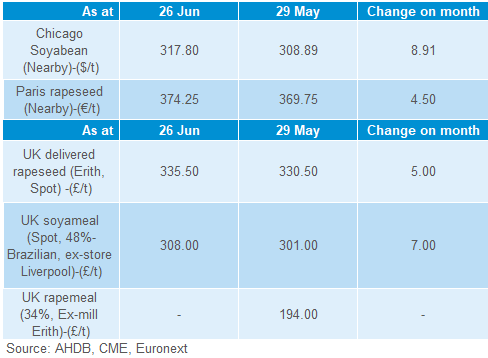Large forecast global stocks expected to cap UK wheat prices: Feed market report
Thursday, 2 July 2020
By Alex Cook and Charlie Reeve
Grains
The domestic grain market has seen both wheat and barley prices fluctuate during June.
UK crop conditions are now varied with some regions, such as South West England, receiving large volumes of rainfall during June, helping crops in many areas improve after the extremely dry spring. Other regions continue to feel the impacts of the dry spring and wet winter which is limiting crop potential.
Overall, this year’s UK harvest is still expected to have a smaller wheat crop and a larger barley crop compared to the previous year.
Looking forward for UK barley prices, it is likely that market will remain pressured throughout the autumn due to a large spring barley crop, creating a necessity for exports. UK barley prices will need to remain competitive in the export market, competing against a large European and global crop.
International grain markets have gone through a period of steady decline during June. Global grain prices have fallen in anticipation of large global stock levels in 2020/21. Wheat production is set to be lower year-on-year in the Ukraine, EU and US. Despite this, stocks in some of the major exporting countries are anticipated to rise, with strong southern hemisphere wheat production especially in Australia.
With the UK wheat crop smaller year-on-year prices are likely to sit at import parity (capped at the import level). As such, the main price drivers will be changes in currency and prices trends in the wider global market.
Major disruptions to global demand for maize and ethanol continue to be caused by coronavirus. Demand for ethanol in South America has been showing signs of growth in June compared to the especially low levels seen in May. However, it is still likely to be a long time until ethanol production returns to the high levels seen before the pandemic. This is therefore likely to be a factor influencing maize markets and UK feed grain markets for some time.
Proteins
In June, global oilseed prices started strong, seeing rises over the first half of the month. This was largely due to two key factors, a significant increase in US soyabean export sales to China, coupled with the easing of lockdown measures in the EU and US. Fuel use will increase as more countries reduce lockdown measures, benefitting biodiesel markets and supporting oilseed prices.
However, recent increases in coronavirus infection rates across the US, Asia and the EU have pressured global oilseed markets. Favourable weather for soyabeans across the US MidWest also offers a degree of pressure. As such, oilseed prices have fallen back from earlier month highs.
Domestic rapeseed markets await the first confirmation of yield estimates. Many growers across the east of England expect to start harvests later this week or the beginning of next, dependant on weather. Oilworld forecast the UK rapeseed crop at 1.12Mt (www.Oilworld.biz) , marking potentially the lowest production figure in over twenty years.
What this means for feed markets is perhaps a greater reliance on imported protein meal. Furthermore, the temporary closure of the Erith crushing plant could affect meal availability for surrounding feed manufacturers.
With a decreased availability of domestic rapeseed, imports are likely to increase in volume to supply the deficit. As a result, UK rapeseed prices are more likely to price at import parity levels, with Ukraine and Australia likely origins.
A forecast bumper US soyabean crop and increased Brazilian stocks could pressure soyameal prices, with a knock-on effect for UK soyameal imports that feature in protein feeds. Soya cake and meal usage in GB feed production increased 3.9% year-on-year in the season to April.
The US acreage report released on Tuesday increased the soyabean area at 83.82Ma, above the March estimate by 0.31Ma.
Currency
Sterling has weakened against the major currencies in June, initially showing some strength against the dollar which then fell away. Brexit talks at the start of the month provided some strength but recent increasing concern for the UK economy from the impact of coronavirus has pressured UK markets. Looking forward, a September soft deadline for finalising Brexit discussion set by the UK prime minister will likely be key to the sentiment over the next few months.
Sign up for regular updates
You can subscribe to receive Beef and Lamb market news straight to your inbox. Simply fill in your contact details on our online form.
While AHDB seeks to ensure that the information contained on this webpage is accurate at the time of publication, no warranty is given in respect of the information and data provided. You are responsible for how you use the information. To the maximum extent permitted by law, AHDB accepts no liability for loss, damage or injury howsoever caused or suffered (including that caused by negligence) directly or indirectly in relation to the information or data provided in this publication.
All intellectual property rights in the information and data on this webpage belong to or are licensed by AHDB. You are authorised to use such information for your internal business purposes only and you must not provide this information to any other third parties, including further publication of the information, or for commercial gain in any way whatsoever without the prior written permission of AHDB for each third party disclosure, publication or commercial arrangement. For more information, please see our Terms of Use and Privacy Notice or contact the Director of Corporate Affairs at info@ahdb.org.uk © Agriculture and Horticulture Development Board. All rights reserved.




